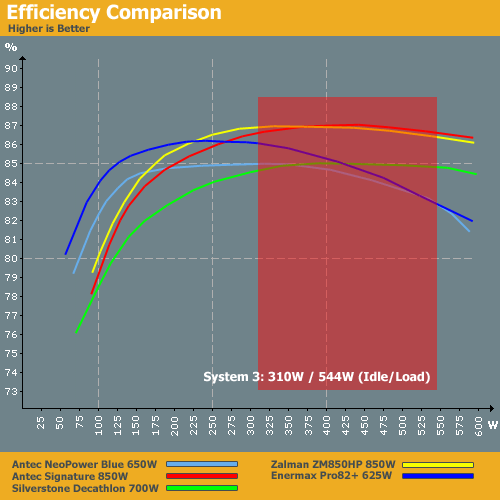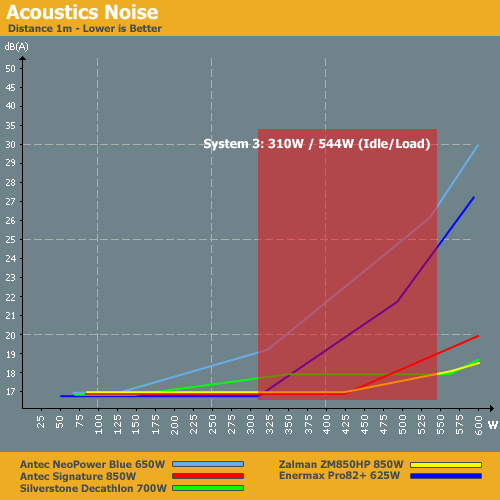Debunking Power Supply Myths
by Christoph Katzer on September 22, 2008 3:00 AM EST- Posted in
- Cases/Cooling/PSUs
PSUs for High-End Systems
Even though our high-end system consumes more power, we used the same graph layout. That means the resulting graphs stop at 600W, despite the high-end PSUs all being capable of providing more power than that. Our high-end system sports an SLI setup using two NVIDIA 8800 ultra cards; 3-way SLI would be a bit more demanding, but we don't feel it's a good indication of what people are actually running. The third card would also only add another 50W to 90W of power consumption to our system, since the third card is rarely taxed as much as the first GPU.
- Antec NeoPower Blue (650W) actively cooled
- Antec Signature (850W) actively cooled
- Silverstone Decathlon (700W) actively cooled
- Zalman ZM850HP (850W) actively cooled
- Enermax Pro82+ (625W) actively cooled

We've included the Enermax Pro82+ 625W from the midrange selection as well. Again, efficiency is not the major issue when it comes to choosing between these products. The two lowest rated power supplies -- Antec NeoPower 650W and Enermax Pro82+ 625W -- are less efficient over the tested range, but that's expected. The results all of her around 85% to 87% mark, and one or 2% difference really isn't going to matter much. Still, the Zalman and Antec 850W units place at the top of this chart.

Again, the two power supplies with the lowest output rating perform worse in this test, generating much more noise than the competition. The higher rated units don't have to work as hard, since they are running at a medium load. Those three PSUs remain very quiet along with providing better efficiency, making them the better for a high-end setup. The Zalman and Antec Signature 850W units would be our choice, if only for the extra headroom. Either PSU would have no difficulty with a 3-way GPU setup, provided you have sufficient PEG connections available. That brings up the next topic of discussion.










98 Comments
View All Comments
7Enigma - Monday, September 22, 2008 - link
20% greater system power? or just for the cpu? If just the CPU what did it equate to system-wise if you don't mind me asking?In an earlier post I mentioned a high-end PSU possibly being better than the mid-grade if you were going to moderately overclock (it was right at the overlap point under heavy load) from a sound and efficiency standpoint. But that was assuming an increase of 20-30% overall.
CK804 - Monday, September 22, 2008 - link
Finally, an article from Anandtech that will really open people's eyes on how much power they actually need.Beenthere - Monday, September 22, 2008 - link
When purchasing a PSU, ignoring the importance of PSU quality and output, in favor of noise and efficiency is foolhardy.Many PSUs do not provide clean power or the rated power - especially under heavy laod. In additional while the article touched on it, depending on the 12V rail design, many PSUs can't deliver the proper power (wattage) to the 12V rail(s) even though the PSU total wattage rating may be more than sufficient . While I'm all for green it is always better to buy a quality PSU that delivers at least 20% more power than you current needs, to provide update headroom and maintain good PSU efficiency and low noise.
If you're not comparing PSU quality, power output per rail and warranty before considering efficiency, noise and cost, then you've missed the point of buying a proper PSU. While most folks do not need a 1000W PSU, many need a quality PSU that can deliver the correct power to each rail and a PSU that will last.
7Enigma - Monday, September 22, 2008 - link
Wouldn't a high efficiency PSU by design be a quality PSU? Generally inferior parts/design are the reason for poor efficiency...mindless1 - Thursday, September 25, 2008 - link
High efficiency doesn't automatically mean high quality per it's own ratings, and an old design not attempting to have high efficiency can still be using reasonably good quality parts and design, unless all your criteria revolve around efficiency being a necessary factor before you'd call a PSU "quality".Take server PSU for example, many don't have such high efficiency but many are higher quality than those used in PCs.
Do you realize that more elaborate filters will reduce efficiency? To some extent, trying to maximize efficiency limits how much quality can be present.
marc1000 - Monday, September 22, 2008 - link
and it is powered by a old Pentium-D 945 (3.4ghz, 90w TDP, and it gets quite hot actually). I also have 1 HDD, 1 DVD-RW, 2GB of ddr2 ram, and one Radeon 3850 512mb.I was in fact using a high-quality 250W PSU, the one that came bundled with the system (I believe it is high-quality because of the build quality and the clear specs, and also because it is a system I bought from HP with "free upgrades option", so I upgraded the CPU+GPU by my own. I wanted a Core2Duo, but my mobo will not accept it.)
whatever. the 250w PSU was working fine, even when I ran old games or 3dmark01. but on 3dmark03/05/06 and newer games, the system was turning itself off after 5 or 10 minutes. so i bought this very quiet AKASA 300w PSU with a single PEG, and now I have a relatively quiet computer that works just fine with no power problems.
this is quite a good gaming machine, if you want to know. I am OK with 20/30 fps, as I am not a hardcore gamer. and I can play GRID at 1680x1050 with almost everything high and 2xAA at this frame rate. also Crysis run fine with everything to medium at this resolution and frame-rate (but this is not so enjoyable because it is a fast-paced FPS). I know that my CPU is the bottleneck, but maybe next year I will change the mobo+CPU.
It is a modest PC, with a modest PSU, for a modest gamer! =)
Insomniac - Monday, September 22, 2008 - link
You said the Corsair VX450W performs best of the low power usage system PSUs. But looking at the charts, it seems the Amacrox Calmer 300W is the best. Its efficiency curve is the highest through the range and its noise curve is the lowest through the range. Was this an oversight or was there a reason this PSU would not work for the midrange system?If it was, that seems like a great PSU. It would be close to the other mid-range PSUs in efficiency and the best for noise. It would be great for a low power system, but has quite a bit of headroom as well.
Christoph Katzer - Monday, September 22, 2008 - link
Since it is passively cooled it has a very limited usability... If you run a few fans it won't be a problem but then you still have the huge price difference between both units.Insomniac - Monday, September 22, 2008 - link
Thanks for the information!duploxxx - Monday, September 22, 2008 - link
Very nice article it really explains the desires and needs what to buy for PSU altough i am missing some top psu's like seasonic for example.Only unfortunate is that some measurements of hardware are way out of range... especially in the motherboard parts.
And if you want to be stay out of who is best... you know the always existing rival that a site has a preferred vendor, take the latest hardware from both sides, if not leave it out.